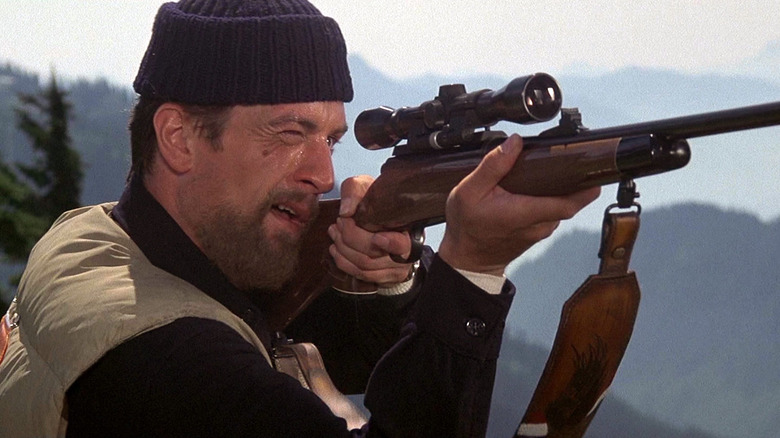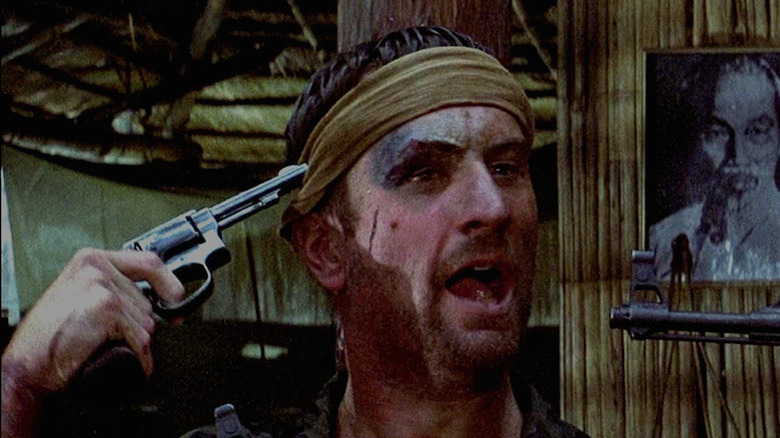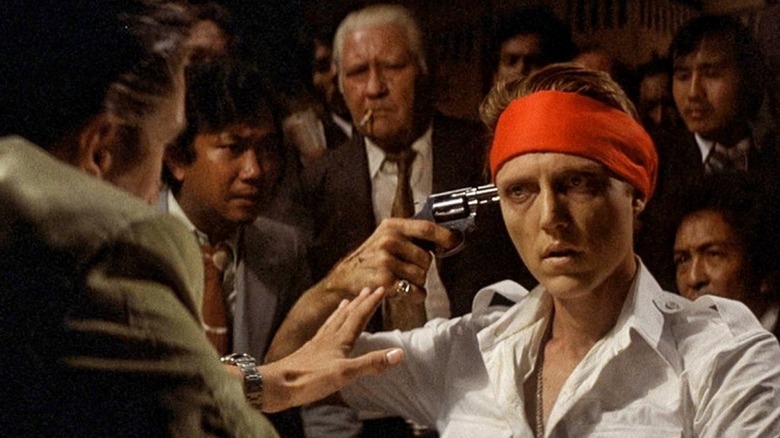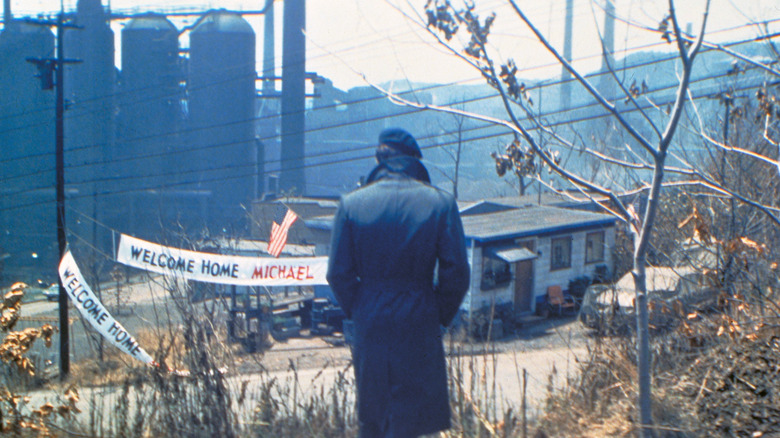The Deer Hunter Ending Explained: There Is No Going Back
At their core, movies are meant to entertain us. However, they are also an art form and avenue to prompt thought and discussion on social issues. Most films rely on a five-part structure in telling a story: exposition, rising action, climax, falling action, and resolution. This tried-and-true structure almost always wraps up the movie with a nice tidy bow, sending audiences home happy with good triumphing over bad.
While this proven method is good for light amusement, it also breeds predictability. Now and again a film will challenge this narrative structure. In doing so, they often stand out and stick with you long after the end credits. There's a reason 1941's "Citizen Kane" remains atop the American Film Institute's Top 100 Films list. It broke nearly every film convention in place at the time, creating techniques still regularly used today.
In 1978, a social problem film examined the impact of the Vietnam War in ways audiences hadn't seen before. Because of this, the ending of "The Deer Hunter" continues to stick with audiences to this day, with its narrative choices frustrating some and moving others.
What Happens When the Protagonist Loses?
"The Deer Hunter," directed by Michael Cimino, examines the way the Vietnam War affects the lives of three men, Mike (Rober De Niro), Nick (Christopher Walken), and Steven (John Savage). The movie is split into three acts: pre-Vietnam normalcy of life in western Pennsylvania as Steven gets married, the three being captured while in Vietnam, and their struggle to reintegrate into society after the war. Cimino and cinematographer Vilmos Zsigmond move us around the town and the wedding reception like voyuers, using wide shots and long takes to emphasize the slow pace of life at home. At the wedding, friends and family dance and regale, not yet damaged by the haze of the war. When it is announced that Nick and Mike are joining Steven in Vietnam, the entire reception cheers and continues dancing, seemingly celebrating the sacrifices the young men are about to make. As Mike, Nick, and Steven encounter a solemn Green Beret at the bar, they go from buying him a drink to laughing along with a friend that calls the soldier a hillbilly. The three are jovial and enthusiastic, oblivious to the horrors that await them.
Cimino introduces viewers to the war with a stark cut from the western Pennsylvania celebrations to the bombing of a Vietnam village, a woman and child being shot and killed, and a Viet Cong soldier being burned alive. Moments earlier, we were watching Nick leaping over a beer mug in a Russian Orthodox wedding celebration — now there is death everywhere. Close-ups are utilized to emphasize emotion and the dark, cramped spaces the men occupy. Western Pennsylvania and Vietnam were on opposite sides of the Earth, literally but also figuratively, something Cimino drives home with this clash in styles. He essentially creates two separate movies when it comes to tone and tenor.
The film continues to splinter from the traditional film structure in a number of ways. In "The Deer Hunter," Nick slowly evolves into the film's antagonist, leading Mike to travel to Saigon to bring him home. In another subversion of the typical cinematic structure, our protagonist is defeated by the antagonist when Nick refuses to return home with Mike and instead kills himself.
No Resolution
The visuals of the climactic scene are harrowing. Mike finally finds Nick, detached and aloof, and pleads with him to come home. Unable to pry him away, Mike is forced to sit across from Nick for a game of Russian Roulette. The tense silence is punctured by the click of the empty chamber with each successive round of the game, followed by a harsh outcry from the crowd packed around them. It becomes more heartbreaking when it seems Nick has a breakthrough, remembering their old hunting days, only to violently turn the gun on himself. The image of blood pouring from the single bullet wound in Nick's temple, his mouth agape, as Mike cradles him yelling, "No, no, no!" sears into your memory. Audiences understandably grapple with Mike coming to the realization that he's failed to save Nick. Good does not triumph over evil, and it's not what audiences have become accustomed to in film.
Warning: the following clip contains disturbing imagery.
Up to this point in 1978, most films tackling war-related mental or physical disability gave characters happy endings with recovery and reintegration into society. The message of "The Deer Hunter" is that there was no coming back from Vietnam. At least not fully.
The film's falling action features Mike and Steven (now using a wheelchair) with friends and loved ones in a somber celebration of Nick's life after his funeral. As Nick's widow sings "God Bless America," the group is left to make sense of what the war has taken from them. The film lacks a resolution, the fifth part of the dramatic structure, naturally leaving audiences unnerved. It is one of the most powerful endings to a film that I can recall. Unfortunately, it is often labeled one of the worst endings ever, and one of the most depressing movies of all time. Unwitting audiences simply didn't (and often still don't) know what to make of it.
Enter New Hollywood
So how did the movie Roger Ebert called "One of the most emotionally shattering films ever made" get produced? That story begins more than a decade before the film was made. Up until 1968, Hollywood films were regulated by The Motion Picture Production Code, also known as "The Hays Code" named after Will Hays, a former Postmaster General who oversaw the MPAA until 1945. Under "The Hays Code," films were held to a strict set of standards that included a ban on some curse words and specific acts of violence and sexuality (ever wonder why all those couples slept in separate beds during Classical Hollywood period?). The advent of television in the 1950s, an influx of foreign films, and court rulings that gave movies First Amendment protection led to the eventual abandonment of the code. In 1968, the MPAA rating system we know today replaced "The Hays Code."
This freedom and a shift from the Hollywood studio system to one that empowered directors launched a new era in Hollywood known as "New Hollywood" or "American New Wave" cinema. With new power and independence, filmmakers began exploring themes once thought untouchable by Hollywood. It led to a decade of films that offered a new take on American life with a gritty realism. Films from this era included "Easy Rider," "Dog Day Afternoon," and "Taxi Driver." Cimino's "The Deer Hunter" was one of the last of the American New Wave period as Hollywood would transition to the Blockbuster formula in the 1980s. This film, and its ending, serve as one of the last gasps of the most unique period in American filmmaking.



